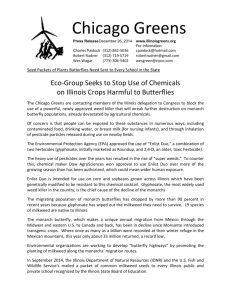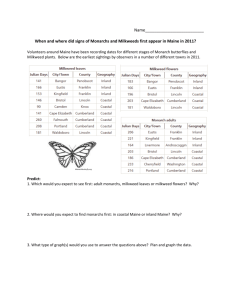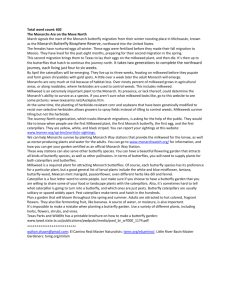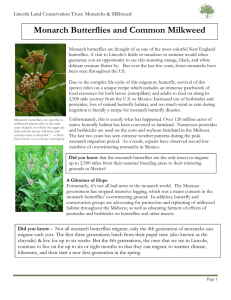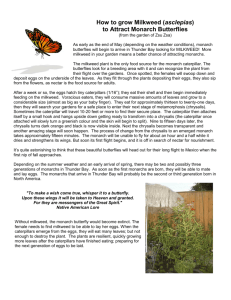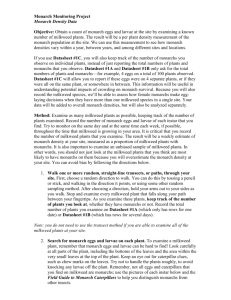Endangered Monarchs - For Your Information
advertisement
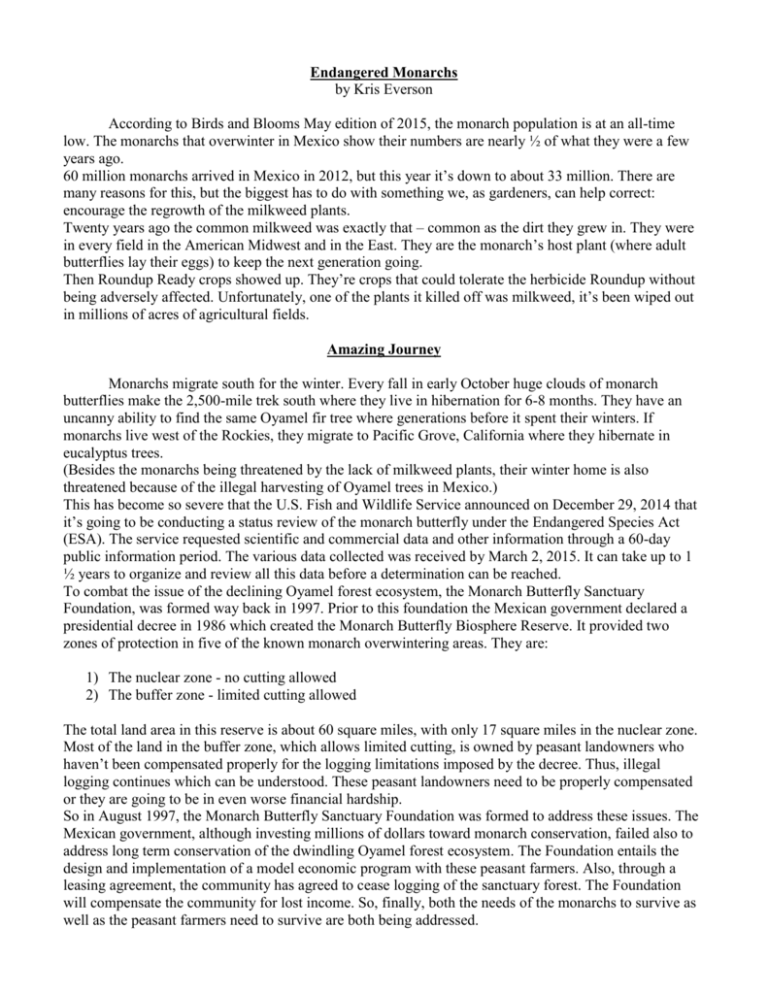
Endangered Monarchs by Kris Everson According to Birds and Blooms May edition of 2015, the monarch population is at an all-time low. The monarchs that overwinter in Mexico show their numbers are nearly ½ of what they were a few years ago. 60 million monarchs arrived in Mexico in 2012, but this year it’s down to about 33 million. There are many reasons for this, but the biggest has to do with something we, as gardeners, can help correct: encourage the regrowth of the milkweed plants. Twenty years ago the common milkweed was exactly that – common as the dirt they grew in. They were in every field in the American Midwest and in the East. They are the monarch’s host plant (where adult butterflies lay their eggs) to keep the next generation going. Then Roundup Ready crops showed up. They’re crops that could tolerate the herbicide Roundup without being adversely affected. Unfortunately, one of the plants it killed off was milkweed, it’s been wiped out in millions of acres of agricultural fields. Amazing Journey Monarchs migrate south for the winter. Every fall in early October huge clouds of monarch butterflies make the 2,500-mile trek south where they live in hibernation for 6-8 months. They have an uncanny ability to find the same Oyamel fir tree where generations before it spent their winters. If monarchs live west of the Rockies, they migrate to Pacific Grove, California where they hibernate in eucalyptus trees. (Besides the monarchs being threatened by the lack of milkweed plants, their winter home is also threatened because of the illegal harvesting of Oyamel trees in Mexico.) This has become so severe that the U.S. Fish and Wildlife Service announced on December 29, 2014 that it’s going to be conducting a status review of the monarch butterfly under the Endangered Species Act (ESA). The service requested scientific and commercial data and other information through a 60-day public information period. The various data collected was received by March 2, 2015. It can take up to 1 ½ years to organize and review all this data before a determination can be reached. To combat the issue of the declining Oyamel forest ecosystem, the Monarch Butterfly Sanctuary Foundation, was formed way back in 1997. Prior to this foundation the Mexican government declared a presidential decree in 1986 which created the Monarch Butterfly Biosphere Reserve. It provided two zones of protection in five of the known monarch overwintering areas. They are: 1) The nuclear zone - no cutting allowed 2) The buffer zone - limited cutting allowed The total land area in this reserve is about 60 square miles, with only 17 square miles in the nuclear zone. Most of the land in the buffer zone, which allows limited cutting, is owned by peasant landowners who haven’t been compensated properly for the logging limitations imposed by the decree. Thus, illegal logging continues which can be understood. These peasant landowners need to be properly compensated or they are going to be in even worse financial hardship. So in August 1997, the Monarch Butterfly Sanctuary Foundation was formed to address these issues. The Mexican government, although investing millions of dollars toward monarch conservation, failed also to address long term conservation of the dwindling Oyamel forest ecosystem. The Foundation entails the design and implementation of a model economic program with these peasant farmers. Also, through a leasing agreement, the community has agreed to cease logging of the sanctuary forest. The Foundation will compensate the community for lost income. So, finally, both the needs of the monarchs to survive as well as the peasant farmers need to survive are both being addressed. Once the monarch emerges from hibernation in Mexico in February or March, it migrates north and east and finds a milkweed plant on which to lay its eggs, usually around March or April. It takes approximately four days for these eggs to hatch into baby caterpillars. They are virtual eating machines, consuming large amounts of only the milkweed plant leaves. After two weeks the now full grown caterpillar finds a place to attach itself and begins the process of metamorphosis. It emerges from the chrysalis after about 10 days. The full grown butterfly only lives about 2-6 weeks during which time it finds a mate and lays its eggs, beginning the life cycle all over again. So, you may ask now, how does the migration work then? Around three generations of monarchs are produced from Mexico up to Canada. One generation goes back to Mexico. They’re able to store sugars/fats in hibernation. Then it mates upon “wakening” and begins its flight north again to lay the first generation of butterflies. Milkweed Luckily, many gardeners are helping to fill the gap. Growing common milkweed is rather easy. Just plant it, water it and wait for the monarchs. If you’re growing from seeds, it may take up to 2-3 years before it flowers. There are more than 100 species of milkweed (Ascelepias) native to America. Only a few species are available to us, though, including bright orange butterfly weed (A. tuberosa), rose-pink swamp milkweed (A. incarnate) and the common milkweed (runners) (A. syrianca). Actually, Asclepias is named for the Greek God of healing. Milkweeds have been used medicinally for thousands of years. Little Known Milkweed Green, heartleaf, narrow-leaved, poke, prairie, purple, sand, showy, spider, tall green, wavy-leaved, whorled, woolly pod. The monarch butterflies began only eating milkweed. It provides all the nourishment needed to transform the caterpillar into the adult butterfly. Sometimes, after the caterpillar becomes a butterfly it can have a much more varied diet. Annuals Coneflowers, impatiens, marigolds, phlox, and sunflowers Perennials Asters, bee balm, butterfly weed, chrysanthemum, daisies, purple coneflower, sedum and yarrow Wildflowers New England aster, bergamots or horsemints, black-eyed Susan, blazing stars, boneset, butterfly flower, coreopsis, ox-eye daisy and purple ageratum Fruits Adult monarchs also like to feed on banana, oranges and watermelon How to Grow Your Milkweed Seeds 1) First soak the seeds overnight 2) Plant them about ¼” below the surface in moist soil (not too deep) 3) They will germinate and sprout in about 14 days 4) Keep ground moist for the first three weeks. After that they’ll take care of themselves. 5) After two months, they will be big enough for caterpillars to eat. Each caterpillar can eat about 20 leaves, so make sure you have enough milkweed or the caterpillars will starve. 6) Milkweed is poisonous to humans. Don’t get the sap on your skin or in your eyes. It’s also toxic to pets when eaten so keep it away so they don’t eat it. Keep it out of reach of children. Various milkweeds thrive in full sun, low sun, in humid conditions and even in very dry conditions. They are perennials so they will come back each year, despite harsh winters in Wisconsin. They typically have rosy pink flowers. Interesting Info 1) 2) 3) 4) 5) 6) Watch ‘Flight of the Butterflies’ in Omnimax or Imax Monarch butterfly webinars Butterflies can catch high winds over Gulf of Mexico to speed migration Some can also hibernate in Florida The yellow, white and black striped caterpillars are the monarchs Monarchs only lay eggs on milkweed Support Needed 1) Dr. Karen Oberhauser, President The Monarch Butterfly Sanctuary Foundation 2078 Skillman Avenue Roseville MN 55113 (Helping to save the Oyamel forest ecosystem in Mexico) 2) Save Our Monarchs Foundation PO Box 390135 Minneapolis, MN 55439 info@saveourmonarchs.org and SaveOurMonarchs.org Ward@SaveOurMonarchs.org (Helping the monarchs here in America) Nonprofit organization Get seeds too! Also provides starter kits 3) Monarch Watch (speaker Dave Hoffman) www.MonarchWatch.org Monarch Waystations (certification) Monarchs Need Milkweed 4) Ray MacNeil 689 Golf Club Lane Frankfort IL 60423 815-469-1294

